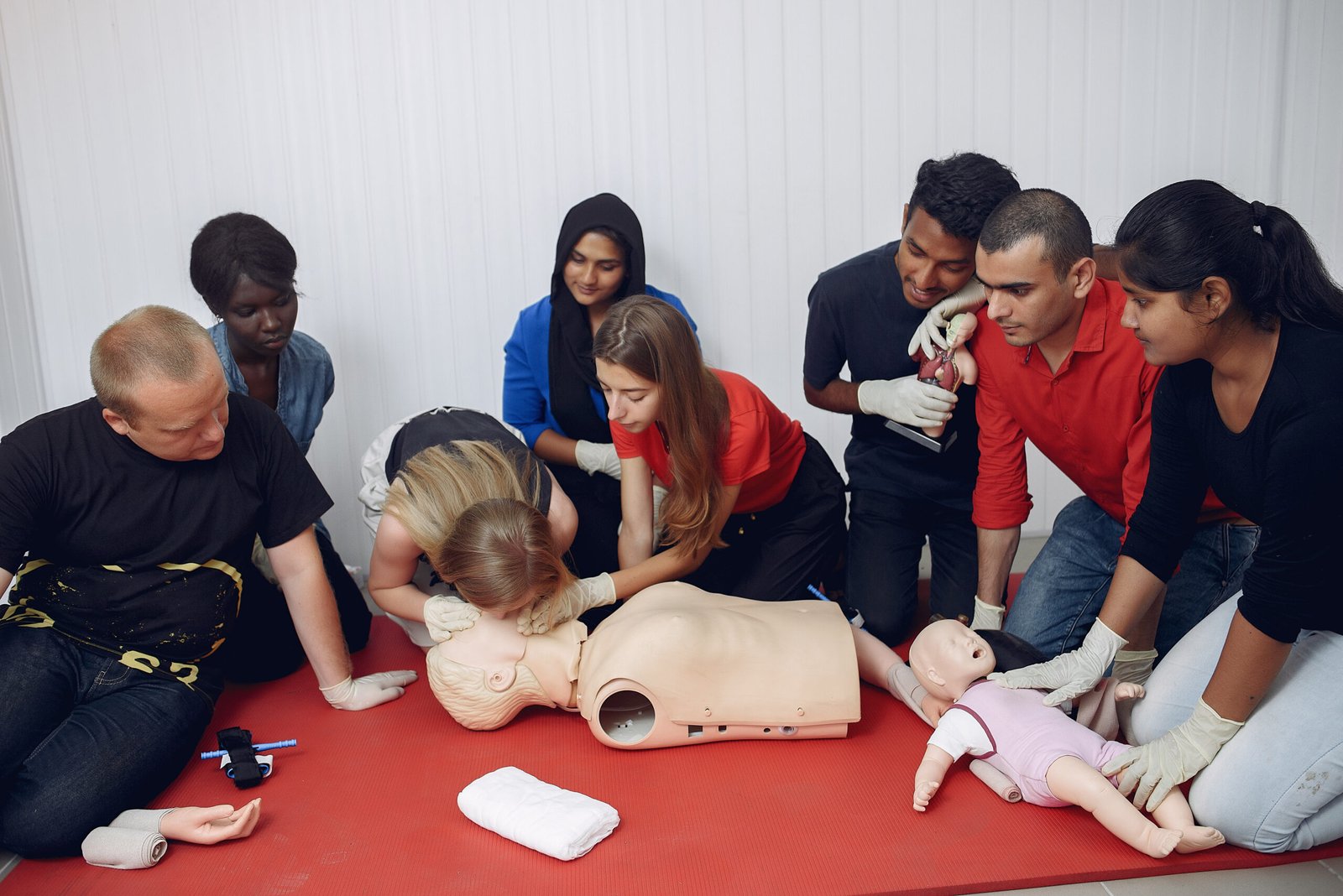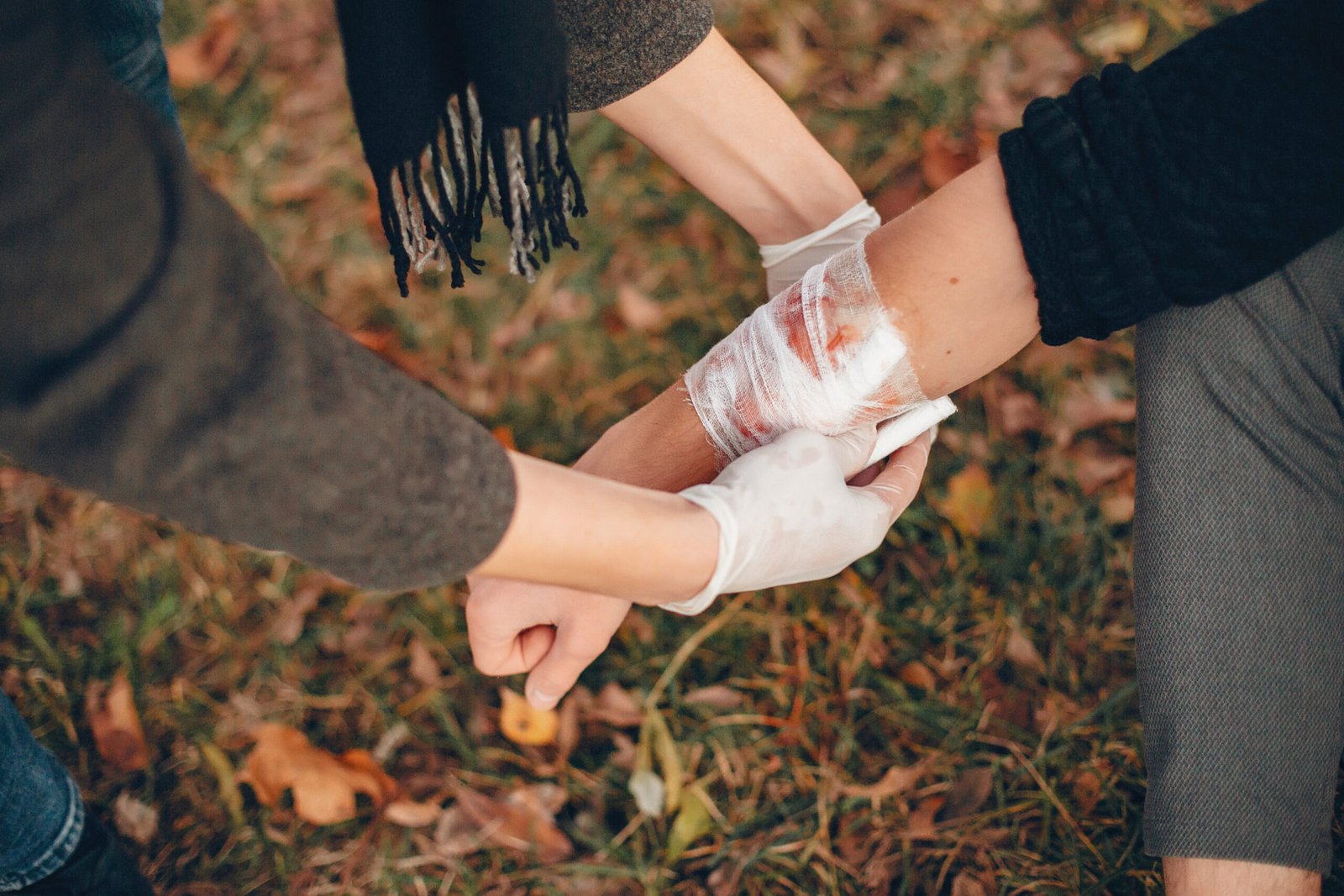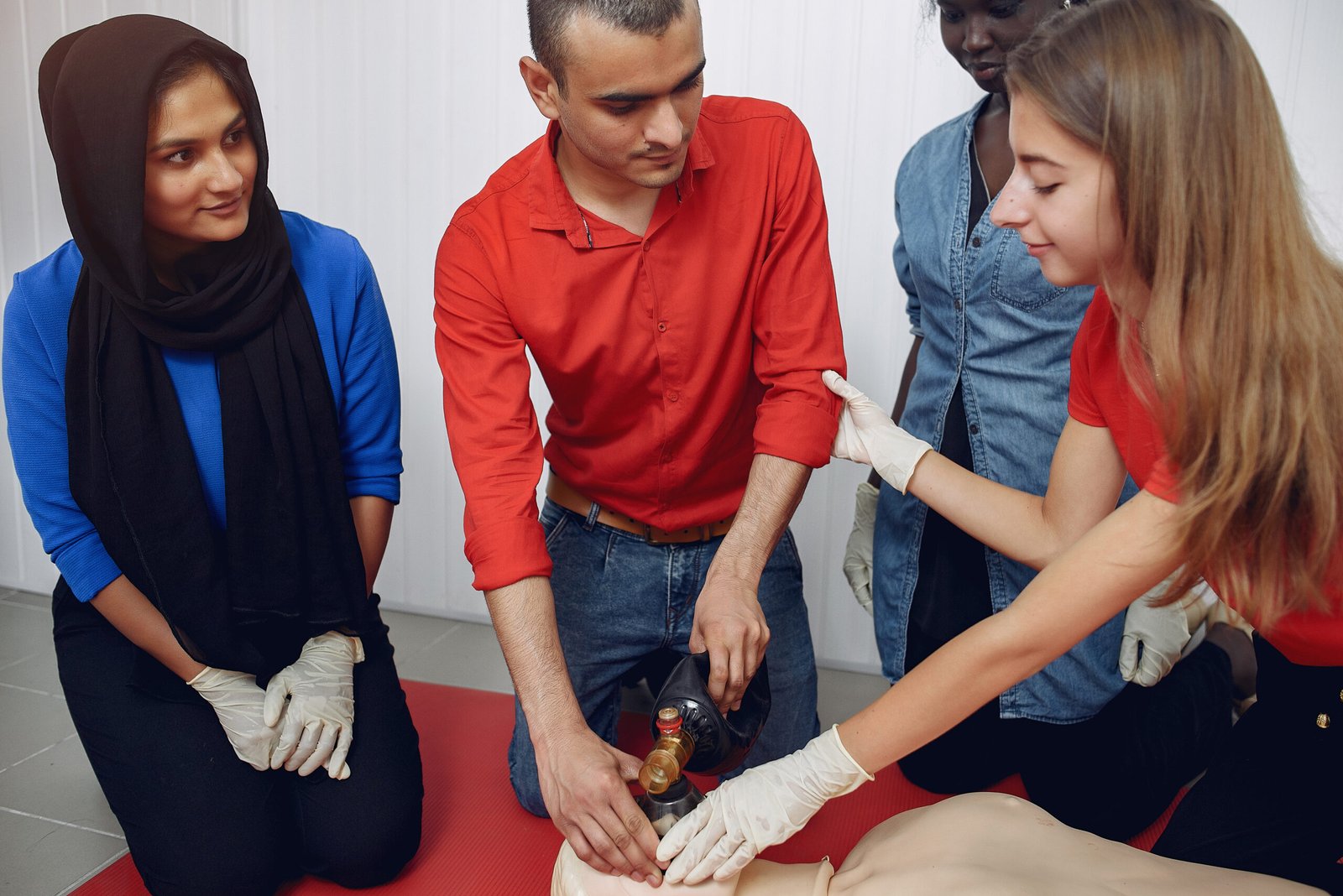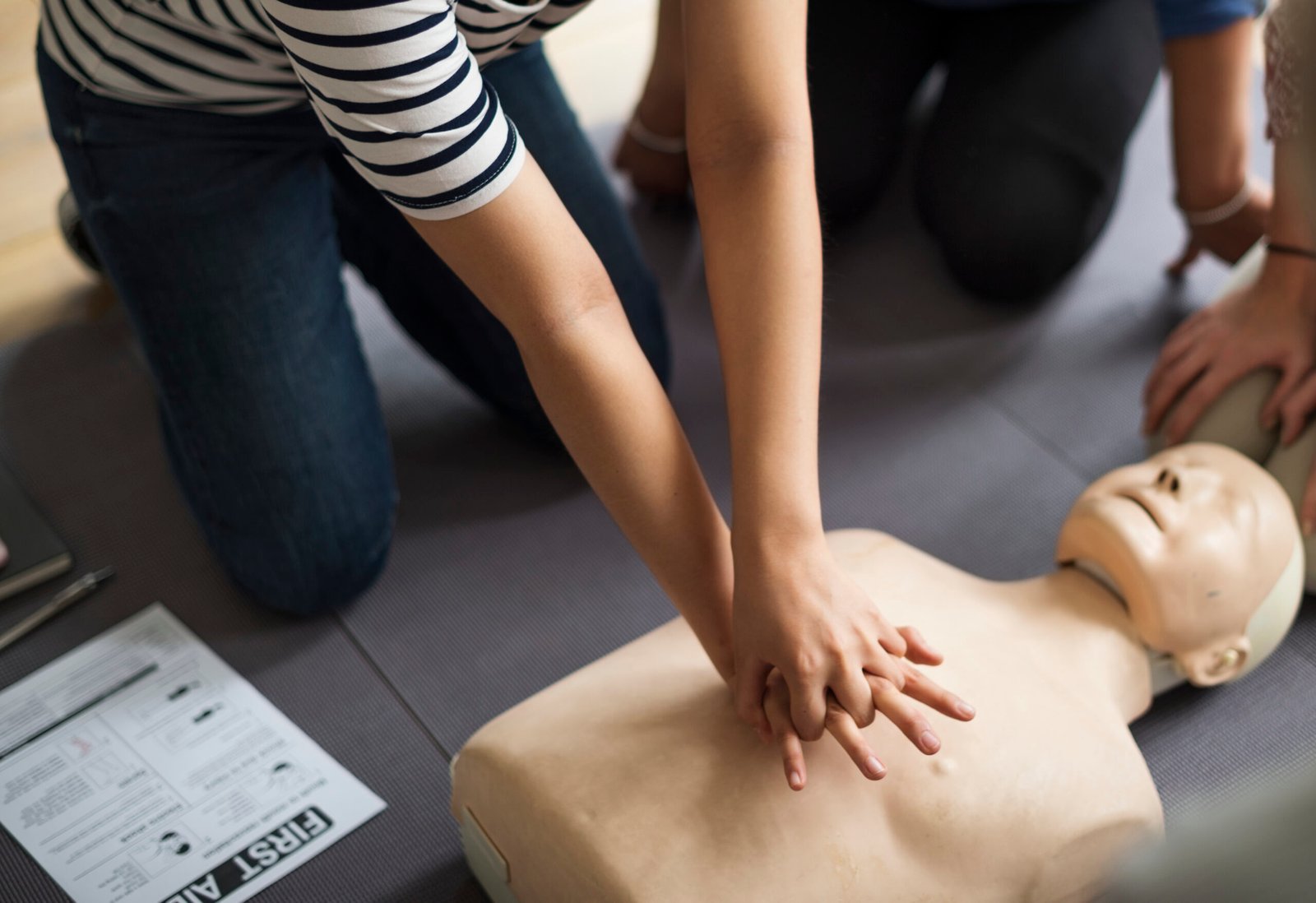In moments of crisis, the ability to perform Cardiopulmonary Resuscitation (CPR) can be the difference between life and loss. At AB First Aid Training, we believe in demystifying CPR, making it a skill accessible to all. In this guide, we break down the steps of CPR, empowering you to be a confident and effective responder in critical situations. 1. The Basics of CPR: What You Need to Know CPR is not just a skill; it’s a life-saving technique that anyone can learn. Understand the crucial role of immediate action during cardiac emergencies. Learn the difference between hands-only CPR and traditional CPR with rescue breaths. 2. Recognizing Signs of Cardiac Arrest Early recognition is key; know the signs of cardiac arrest. Illustrate scenarios where prompt CPR intervention is vital.. Understand the psychological aspects of responding to emergencies. 3. Step-by-Step Guide to Hands-Only CPR Follow a detailed tutorial for hands-only CPR. Learn the correct hand placement and compression rate. Gain confidence in maintaining the proper rhythm during chest compressions. 4. Traditional CPR: Adding Rescue Breaths Delve into the steps of traditional CPR with rescue breaths. Overcome hesitations about rescue breaths by understanding their importance. Master the technique of opening the airway for effective breath delivery. 5. CPR for Special Populations Adapt CPR techniques for infants, children, and pregnant individuals Address unique considerations for diverse age groups Emphasize the importance of flexibility in applying CPR based on the victim’s needs Conclusion: In conclusion, CPR is a skill that transcends age, gender, and occupation. By demystifying CPR, AB First Aid Training aims to empower you to be a confident responder in times of crisis. Remember, being prepared to save a life starts with the right knowledge. Take the first step towards preparedness with AB First Aid Training. Questions for Reflection: Can you recall a situation where knowing CPR could have made a significant impact? How can learning CPR contribute to a safer and more prepared community? Sources: Australian Resuscitation Council. “Guideline 8 – Cardiopulmonary Resuscitation (CPR) Heart Foundation Australia. “CPR – Fact Sheet.” Better Health Channel, Victoria. “Cardiopulmonary Resuscitation Australian Government – Department of Health. “Chain of Survival.” Beyond Blue. “Crisis Support. Raising Children Network. “Child First Aid.” For hands-on CPR training and to boost your confidence in life-saving skills, book your course with AB First Aid Training at www.abfirstaid.com.au or call us at 03 8364 8984. Your ability to save a life starts with the right knowledge. Feel free to let me know if you’d like any adjustments or if you have the next topic in mind!
Cool Heads Prevail: First Aid for Managing Heat-Related Illnesses
As the mercury rises, the risk of heat-related illnesses becomes a pressing concern. AB First Aid Training is here to guide you through effective strategies to manage heat-related issues, ensuring you stay cool and confident in any scorching situation. Beat the Heat: Your Comprehensive Guide to Managing Heat-Related Illnesses Recognizing the Signs of Heat-Related Illnesses: Understand the symptoms of heat exhaustion and heatstroke, and learn to distinguish between the two. AB First Aid Training offers insights into early warning signs that could save a life. First Aid for Heat Exhaustion: Explore practical techniques for assisting someone experiencing heat exhaustion, from moving them to a cooler place to providing hydration. Our courses emphasize quick and effective responses to prevent the condition from escalating. Emergency Measures for Heatstroke: Delve into the immediate actions required when confronted with a heatstroke situation. AB First Aid Training provides hands-on training to ensure you are equipped to handle these emergencies confidently. Preventing Heat-Related Issues: Learn proactive measures to prevent heat-related illnesses, from staying hydrated to recognizing the importance of breaks in hot environments. Our courses emphasize the importance of prevention in addition to effective response. Conclusion: In the scorching heat, being armed with the knowledge to manage heat-related illnesses is as crucial as staying hydrated. AB First Aid Training is committed to preparing you to handle hot weather challenges with confidence. Ready to stay cool under pressure? Book a course with AB First Aid Training today. Call us at 03 8364 8984 or visit www.abfirstaid.com.au to secure your spot. How do you stay cool during hot weather, and what steps would you take if someone around you showed signs of heat-related distress? Share your experiences below and let’s beat the heat together. Questions for Reflection: Can you recall a situation where avoiding a common first aid mistake could have improved the outcome? How can enhancing your first aid knowledge contribute to a safer community? Sources: Australian Government Bureau of Meteorology. (www.bom.gov.au) Better Health Channel – Victoria State Government. (www.betterhealth.vic.gov.au) Australian Red Cross. (www.redcross.org.au) Sports Medicine Australia. (www.sma.org.au)
Common First Aid Mistakes and How to Avoid Them
In moments of crisis, the instinct to help is commendable, but well-intentioned actions can sometimes lead to unintended consequences. At AB First Aid Training, we understand that avoiding common first aid mistakes is as crucial as learning the techniques. In this guide, we’ll explore these pitfalls and equip you with the knowledge to navigate emergencies effectively. 1. Panicking Under Pressure Understand the impact of panic on decision-making during emergencies. Learn calming techniques to maintain focus in high-stress situations. Practice mindfulness to enhance your ability to think clearly in crises. 2. Neglecting Scene Safety Emphasize the importance of assessing the scene for safety. Avoid becoming a victim yourself by ensuring a secure environment. Highlight the correlation between rescuer safety and successful interventions. 3. Ignoring ABCs: Airway, Breathing, Circulation Reinforce the significance of assessing airway, breathing, and circulation in that order. Discuss the potential consequences of neglecting any of the ABCs. Emphasize the need for immediate action if any of the ABCs are compromised. 4. Overlooking the Importance of Calling for Help Stress the critical role of professional help in emergencies. Explain the value of early activation of emergency medical services. Encourage timely communication with emergency services. 5. Misusing First Aid Equipment Provide insights into common mistakes with first aid equipment. Demonstrate correct usage of items like bandages, tourniquets, and AEDs. Offer practical tips for maintaining and checking your first aid kit regularly. Conclusion: In conclusion, avoiding common first aid mistakes is an integral part of being an effective first responder. AB First Aid Training is dedicated to providing you with the knowledge and skills to navigate emergencies confidently. By learning from these pitfalls, you’re not just avoiding mistakes; you’re ensuring a more secure and supportive response when it matters most. Questions for Reflection: Can you recall a situation where avoiding a common first aid mistake could have improved the outcome? How can enhancing your first aid knowledge contribute to a safer community? Sources: [1]: Australian Psychological Society. “Managing stress and anxiety in a crisis.” [2]: Beyond Blue. “Mental health coping strategies.” [3]: St John Ambulance Australia. “First Aid Action Plan.” [4]: WorkSafe Victoria. “First Aid in the Workplace Code of Practice.” [5]: Australian Resuscitation Council. “Guideline 8 – Cardiopulmonary Resuscitation (CPR).”[6]: Better Health Channel, Victoria. “Cardiopulmonary Resuscitation (CPR).”[7]: Australian Government – Department of Health. “Emergency Information.”[8]: Australian Resuscitation Council. “Guideline 9 – Emergency Care.”[9]: Queensland Government. “First aid equipment and facilities.”[10]: First Aid Training Melbourne. “AED Usage.” For comprehensive first aid training and to ensure you’re equipped to respond effectively, book your course with AB First Aid Training at www.abfirstaid.com.au or call us at 03 8364 8984. Your safety starts with the right knowledge.
Childproofing Your World: First Aid for Parents
Parenthood is a beautiful journey filled with joy, laughter, and, inevitably, a few bumps and bruises along the way. As parents, ensuring the safety of our little ones is a top priority. In this blog, we’ll explore essential first aid tips and childproofing strategies to navigate the adventures of parenting confidently. 1. The Art of Childproofing Why it Matters: Young children are naturally curious, which often leads them to explore potentially hazardous areas in the home. Childproofing reduces the risk of preventable accidents. Practical Tips: Secure furniture such as bookshelves and TVs to walls to prevent tipping. Cover electrical outlets with safety caps and keep cords out of reach. Install baby gates at the top and bottom of staircases. Store sharp objects, cleaning supplies, and medications in locked cabinets. Use corner protectors on sharp table edges. Ensure windows are secured with childproof locks or guards.s 2. Common Childhood Injuries and First Aid Solutions Falls: Solution: If the child falls and has no severe head injury or broken bones, clean minor scrapes with soap and water and apply an antiseptic and a bandage. For bumps on the head, apply a cold compress and monitor for symptoms like dizziness or vomiting. Cuts: Solution: Clean the wound with water, stop bleeding with gentle pressure, and cover with a sterile dressing. Seek medical help if the cut is deep or bleeding heavily. Insect Bites: Solution: Wash the bite area with soap and water, apply a cold pack to reduce swelling, and use an antihistamine cream for itching. Watch for signs of allergic reactions, such as swelling, difficulty breathing, or hives, and call emergency services if necessary. 3. First Aid Kit Essentials for Parents on the Go Key Items for Your Kit: Adhesive bandages of various sizes. Sterile gauze pads and adhesive tape. Antiseptic wipes and antibiotic ointment. Tweezers for splinter removal. Digital thermometer for checking fevers. Child-safe pain reliever like acetaminophen or ibuprofen. Instant cold packs for swelling and sprains. Scissors, gloves, and an emergency contact card. Saline solution for cleaning wounds or flushing eyes. Pro Tip: Keep a compact version in your car and a fully stocked kit at home. Regularly check for expired medications and replace them. 4. Recognizing and Responding to Childhood Illnesses Fever: Solution: Use a digital thermometer to monitor the temperature. Keep the child hydrated and use fever-reducing medication as advised by a doctor. Seek medical attention if the fever persists for more than 48 hours or is accompanied by other symptoms like rashes or seizures. Coughs and Colds: Solution: Use a humidifier to ease breathing, and encourage fluids to keep your child hydrated. For persistent or severe coughs, consult a pediatrician. Allergies: Solution: Administer antihistamines as recommended and watch for severe allergic reactions (anaphylaxis), which require immediate medical attention. Carry an epinephrine auto-injector if prescribed. 5. Beyond Band-Aids: CPR and Choking Relief for Parents CPR Guidelines: For infants (under 1 year): Place two fingers in the center of the chest, just below the nipple line, and perform 30 gentle compressions followed by two rescue breaths. Repeat until help arrives or the baby starts breathing. For children (1 year and older): Use one or both hands (depending on child size) to give 30 chest compressions and two rescue breaths. Choking Relief: For infants: Support the baby’s head and neck, place them face-down along your forearm, and give five back blows between the shoulder blades. Turn the baby over and perform five chest thrusts with two fingers in the center of the chest. For children: Stand behind the child, make a fist just above the navel, and perform quick upward abdominal thrusts (Heimlich maneuver) until the object is expelled. Emphasize: Attend a certified first aid course to practice and build confidence in these life-saving techniques. Conclusion: Parenting is an incredible journey, and being prepared for the unexpected is part of the adventure. AB First Aid Training is here to support you on your parenting path by offering comprehensive first aid courses. Equip yourself with the skills and knowledge to handle any situation, ensuring the safety and well-being of your little ones. Questions for Reflection: Congratulations, you’ve now mastered the art of first aid for choking! With AB First Aid Training, you’re not just learning; you’re gaining the skills to be a calm and effective responder in emergency situations. Share your newfound knowledge and inspire others to join the mission of creating a safer, more prepared community. What aspect of choking first aid resonated with you the most, and how do you plan to share this life-saving information with your community? Share your thoughts below and let’s make preparedness a shared mission! Sources: Raising Children Network – Child Safety at Home Kids Health – First Aid for Parents Royal Children’s Hospital Melbourne – Child Safety Australian Parenting Website – Common Childhood Illnesses Healthdirect – CPR for Babies and Children Child Accident Prevention Foundation of Australia – First Aid Tips To book your comprehensive first aid course with AB First Aid Training, visit www.abfirstaid.com.au or call us at 03 8364 8984.
Mastering First Aid for Choking Emergencies with AB First Aid Training
Welcome to the life-saving world of first aid! In this blog post, we’ll dive into the crucial topic of first aid for choking, empowering you with the skills to act confidently in an emergency. With AB First Aid Training as your beacon of knowledge, you’ll not only learn the essentials but also be well-prepared to handle choking incidents effectively. 1. Recognizing the Signs: The Language of Choking Choking can happen unexpectedly, and recognizing the signs is the first step to providing effective first aid. Our guide decodes the language of choking, detailing the symptoms and emphasizing the importance of quick action. AB First Aid Training’s expert instructors ensure you’re not just aware but adept in identifying and responding to choking emergencies. Pro Tip: AB First Aid Training offers hands-on choking emergency simulations in their courses. Check out their upcoming sessions here to elevate your life-saving skills. 2. Hands-On Techniques: A Symphony of First Aid Moves Discover the hands-on techniques taught by AB First Aid Training to dislodge an obstruction and restore breathing. From the Heimlich maneuver to back blows, our guide provides a step-by-step symphony of first aid moves that can make a significant difference in a choking emergency. Pro Tip: Ready to be a first aid hero? Enroll in AB First Aid Training’s courses now and gain the confidence to respond effectively to choking incidents. 3. Prevention is the Best Cure: Tips for Choking Prevention AB First Aid Training goes beyond reactive measures; they empower you with proactive tips for preventing choking incidents. Explore practical advice on food safety, creating a safer environment, and becoming an advocate for awareness. By integrating preventive measures into your daily routine, you contribute to a community focused on safety. Pro Tip: Join AB First Aid Training’s community of safety-conscious individuals. Book your course now and be part of the movement towards a safer environment. Conclusion: Creating inclusive learning environments that prioritise student mental health is essential for their academic success and overall well-being. At AB First Aid Training, we believe that supporting mental health in education is a fundamental aspect of creating a positive and nurturing learning environment. Let’s work together to empower students to take care of their mental health and ensure that no one feels alone in their struggles. Questions for Reflection: Congratulations, you’ve now mastered the art of first aid for choking! With AB First Aid Training, you’re not just learning; you’re gaining the skills to be a calm and effective responder in emergency situations. Share your newfound knowledge and inspire others to join the mission of creating a safer, more prepared community. What aspect of choking first aid resonated with you the most, and how do you plan to share this life-saving information with your community? Share your thoughts below and let’s make preparedness a shared mission! Sources: Australian Resuscitation Council. “Guideline 9.2.5 – Foreign Body Airway Obstruction (FBAO).” Better Health Channel. “Choking.” St John Ambulance Australia. “Choking.” AB First Aid Training. “Upcoming Choking Emergency Simulations.” AB First Aid Training. “Book Your First Aid Course Now.”
Mastering Emergency Response 101 with AB First Aid Training
Imagine a moment where quick and effective first aid can make the difference between life and death. In our fast-paced lives, being equipped with Emergency Response 101 skills can turn anyone into a hero. Let’s delve into the world of rapid response and discover how you can be the difference in an emergency. The Importance of Quick Response: In the critical first moments of an emergency, time is of the essence. According to Emergency Management Australia[^1^], the golden hour principle emphasizes the significance of rapid response in improving outcomes during emergencies. The quicker you can initiate first aid, the better the chances of a positive outcome. Essential First Aid Steps: A Quick Guide: Mastering the basics of first aid is the foundation of effective emergency response. Understanding the essential steps can empower you to act swiftly and confidently in various scenarios. Whether it’s performing CPR or addressing a choking incident, these skills are invaluable. The Australian Resuscitation Council[^2^] and St John Ambulance Australia[^3^] provide comprehensive guidelines for basic first aid techniques. AB First Aid Training’s Rapid Response Approach: At AB First Aid Training, we understand the urgency of quick and effective first aid. Our courses are designed to equip you with the skills needed to be a first responder in emergencies. Our practical, scenario-based training ensures that you are not just learning theoretical concepts but are prepared to apply them in real-life situations. Real-Life Stories: When Seconds Made the Difference: Consider the story of Sarah, who, after attending an Emergency Response 101 course, confidently performed CPR on a stranger until professional help arrived. Moments like these showcase the impact of quick and effective first aid. Conclusion: In your everyday life, emergencies can happen when least expected. How prepared are you to be the hero in those critical moments? AB First Aid Training offers Emergency Response 101 courses that not only teach you the necessary skills but empower you to use them confidently. Are you ready to take the first step in becoming a lifesaver? Questions for Reflection: Imagine a scenario where your quick response saves a life. How does that make you feel, and what steps are you willing to take to be prepared for such moments? Sources: Emergency Management Australia Australian Resuscitation Council St John Ambulance Australia Book your Emergency Response 101 course with AB First Aid Training at www.abfirstaid.com.au or call 03 8364 8984. Remember, being prepared is not just a skill—it’s a mindset. Enroll in our Emergency Response 101 course today and be the hero when it matters most.
Mastering the ABCs of CPR: A Comprehensive Guide to Life-Saving Techniques
Imagine being in a situation where someone’s life depends on your quick and knowledgeable response. That’s where the ABCs of CPR come into play – a fundamental skill that empowers you to be a real-life superhero in an emergency. At AB First Aid Training, we believe that everyone should have the confidence and skills to save a life. In this blog post, we’ll delve into the ABCs of CPR, providing you with insights that could make all the difference when it truly matters. A is for Airway When faced with a medical emergency, the first step is ensuring an open aiway. Proper positioning of the head and neck is crucial to allow for unrestricted breathing. At AB First Aid Training, our instructors emphasize the importanrce of recognizing airway obstructions and applying techniques to clear them effectively. Learn more about maintaining an open airway. B is for Breathing Once the airway is clear, focus shifts to breathing. Effective rescue breaths can mean the difference between life and death. Our courses at AB First Aid Training not only teach you how to provide rescue breaths but also guide you on assessing the victim’s breathing patterns. Explore the importance of rescue breaths C is for Circulation Circulation involves the crucial step of chest compressions. At AB First Aid Training, our courses teach you the correct hand placement, depth, and pace of compressions to maximize blood circulation. We understand that these actions are the heartbeat of CPR, driving oxygen to vital organs and keeping the person alive until professional help arrives. Master the art of chest compressions Conclusion: In conclusion, mastering the ABCs of CPR is not just a skill; it’s a lifesaving tool that can empower you to make a difference when every second counts. AB First Aid Training is dedicated to ensuring you are well-equipped with the knowledge and confidence to handle emergencies effectively. Are you ready to be someone’s hero? Questions for Reflection: Have you ever found yourself in a situation where CPR knowledge would have made a difference? What steps can you take to encourage others to learn the ABCs of CPR? Sources: Australian Resuscitation Council. (www.resus.org.au) St John Ambulance Australia. (www.stjohn.org.au) Australian Red Cross. (www.redcross.org.au) HealthDirect Australia. (www.healthdirect.gov.au) AB First Aid Training: Book your CPR course now | Call us at 03 8364 8984.
First Aid for Allergies: Identifying and Responding to Reactions
In a world marked by diverse experiences, allergies can impact anyone at any moment. Whether you’re a parent, educator, or individual navigating daily life, knowing how to recognize and manage allergic reactions is crucial. Join us on this journey into first aid for allergies, where AB First Aid Training will guide you through steps ensuring safety and preparedness for yourself and your community. 1. The Growing Challenge of Allergies in Australia Delve into the increasing prevalence of allergies in Australia, particularly among both children and adults. Stress the importance of preparedness to handle allergic reactions across various settings. 2. Common Allergens: Understanding the Triggers Provide an overview of common allergens, encompassing food, insect stings, medications, and environmental factors. Emphasize the need for awareness to prevent exposure to recognized allergens. 3. Recognizing Allergic Reactions: Indicators and Symptoms Outline the signs and symptoms of allergic reactions, spanning from mild to severe. Share relatable scenarios to help readers identify potential allergic responses in themselves or others. 4. First Aid Measures for Allergic Reactions Offer step-by-step first aid instructions for managing allergic reactions, including the proper use of auto-injectors in severe cases. Highlight the significance of seeking professional medical assistance post-administration of initial first aid. 5. Cultivating an Allergy-Aware Community: Training Opportunities Introduce the concept of an allergy-aware community and underscore the role individuals play in establishing a safe environment. Highlight the training opportunities provided by AB First Aid Training, empowering individuals to become confident first responders. Conclusion: Allergic reactions may be unpredictable, but your ability to respond with first aid knowledge can be a game-changer. AB First Aid Training is your ally on the path to allergy awareness and preparedness. Take the initial step toward a safer community by enrolling in our comprehensive first aid courses. Have you or someone you know encountered an allergic reaction? How has first aid knowledge helped you navigate these situations? Share your stories and insights below. Sources: ASCIA – Allergy Statistics Healthdirect – Anaphylaxis Overview Australasian Society of Clinical Immunology and Allergy – Allergy Information Australian Government Department of Health – Allergy and Anaphylaxis Management National Asthma Council Australia – First Aid for Allergic Reactions To book your comprehensive first aid course with AB First Aid Training, visit www.abfirstaid.com.au or call us at 03 8364 8984.
Clear Vision: First Aid for Eye Injuries Made Simple
Our eyes are precious, and in the blink of an eye, an accident can happen. Knowing how to respond to eye injuries is crucial for preserving vision and preventing further damage. Join AB First Aid Training on a journey to master quick and effective responses for eye injuries. Responding Swiftly to Eye Injuries: A Definitive Guide Assessing the Situation: Understand the different types of eye injuries, from minor irritations to more severe trauma. Learn how to quickly assess the situation to provide the most effective assistance. Irritant Removal Techniques: Discover the proper steps for flushing the eye in case of exposure to chemicals, dust, or foreign objects. Our courses provide hands-on training, ensuring you can confidently handle these situations. Dealing with Foreign Objects: Explore the best practices for safely removing foreign objects from the eye without causing further harm. AB First Aid Training offers insights into techniques and tools for a safe extraction. Treating Cuts and Abrasions: Delve into the steps for treating cuts, scratches, and abrasions around the eye area. We provide practical demonstrations to enhance your skills in managing these delicate injuries. Conclusion: In the realm of first aid, addressing eye injuries requires precision and knowledge. AB First Aid Training is dedicated to equipping you with the expertise needed to respond swiftly and effectively in these critical moments. Ready to enhance your first aid skills for eye injuries? Book a course with AB First Aid Training today. Call us at 03 8364 8984 or visit www.abfirstaid.com.au to secure your spot. What steps would you take if someone around you experienced an eye injury? Share your insights below and let’s spread awareness on eye injury first aid. Sources: Royal Australian and New Zealand College of Ophthalmologists. (www.ranzco.edu) Vision Eye Institute. (www.visioneyeinstitute.com.au) Australian Government Department of Health. (www.health.gov.au) Australian and New Zealand Eye Foundation. (www.anzef.org.au)
Teaching Water Safety in Australian Classrooms: Creative Ideas for Keeping Students Safe in the Water
Water safety is a crucial life skill for students in Australia, a country surrounded by beautiful beaches and countless opportunities for aquatic activities. In this blog post, we will explore the importance of teaching water safety in Australian classrooms and provide creative and engaging ideas for teachers to ensure their students are well-prepared to enjoy the water safely. At AB First Aid Training, we understand the significance of water safety, and our courses offer comprehensive insights into this vital skill. To learn more about how our training can benefit educators and students, visit our website AB First Aid Training or call us at 03 8364 8984. Teaching Water Safety in the Classroom: Understanding Water Hazards: Educate students about the potential dangers of various water environments, including the ocean, pools, and rivers. Basic Swimming Skills: Provide basic swimming lessons or encourage students to take swimming classes to build essential water skills. Watercraft Safety: Discuss safety measures for various watercraft, such as boats, kayaks, and paddleboards. Rip Current Awareness: Teach students about the risks of rip currents at the beach and how to identify and respond to them. Life Jacket Use: Demonstrate the importance of wearing life jackets and how to properly fit and use them. CPR and Water Rescue: Offer basic instruction on cardiopulmonary resuscitation (CPR) and water rescue techniques for emergency situations. Creative Water Safety Ideas for Teachers: Water Safety Games: Develop games and activities that teach water safety principles, such as water tag or a “rescue relay.” Guest Speakers: Invite lifeguards, surfers, or members of the local coast guard to share their expertise and real-life experiences with water safety. Simulated Water Scenarios: Create simulations of water emergencies in a controlled environment where students can practice their response skills. Water Safety Art Projects: Encourage students to express their understanding of water safety through art, creating posters or illustrations. Beach or Pool Field Trips: Organise field trips to nearby beaches or pools for practical lessons in a supervised environment. Water Safety Quizzes: Conduct quizzes or trivia games to test students’ knowledge of water safety. Conclusion: Teaching water safety in Australian classrooms is not only about imparting knowledge but also about preparing students for a lifetime of safe and enjoyable experiences in the water. At AB First Aid Training, we believe that water safety is a fundamental aspect of overall well-being. Let’s work together to empower the next generation to enjoy the water safely. Questions for Reflection: How do you prioritise and teach water safety in your classroom, and what strategies have you found effective in ensuring students are well-prepared for water-related activities? Have you ever encountered a situation where knowledge of water safety made a significant difference in keeping a student safe in the water? What creative ideas do you have for making water safety education engaging and memorable for your students? Sources: Water Safety Education – Royal Life Saving Society Australia Water Safety Tips – Surf Life Saving Australia AB First Aid Training Courses Contact us at AB First Aid Training: 03 8364 8984









